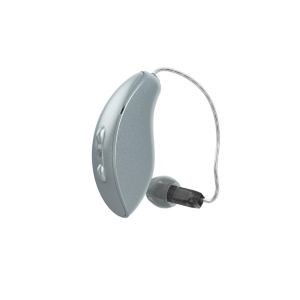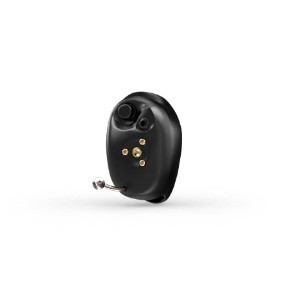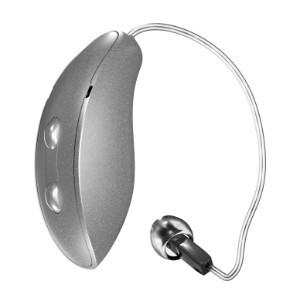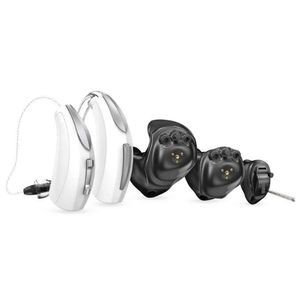Starkey Hearing Aids UK
Reviews, Models, Ratings & Prices
| Hearing Aid UK 2025-11-11 Update |
Overview
Starkey is the only American-owned hearing aid brand, known for innovation and philanthropy. They've introduced many industry firsts, like invisible and health-monitoring hearing aids.
Popular models include Genesis AI, Signature Series, and Edge AI, offering AI-powered sound, Bluetooth, rechargeability, and health tracking.
With user-friendly apps and support for tinnitus and spatial awareness, Starkey delivers smart, discreet hearing solutions for all lifestyles and budgets.
Table of Contents:
►History of Starkey hearing aids
►Starkey hearing aid technology
►Chat to us about Starkey hearing aids
Brief history of Starkey hearing aids
Starkey is the only American hearing aid manufacturer, and three out of the main manufacturers come from Denmark. They're the only privately owned manufacturer, and the owner is billionaire Bill Austin from Texas. Over the last few years, they have developed some amazing and innovative hearing aid technology.
The Starkey hearing aid range is designed to help you experience great hearing. It captures every sound, whether it’s children's laughter or conversations in bustling places like pubs and restaurants.
Even as it expanded to over 100 markets with 500+ employees, Starkey kept its American roots strong, even providing hearing aids to Presidents Reagan and Clinton.
Giving back has also been a big part of its mission. Since 1984, the Starkey Hearing Foundation has donated over a million hearing aids worldwide.
Why choose Starkey?
- Industry firsts: First in-ear hearing aid (1971), first Completely-in-Canal aid (1992), first Invisible-in-Canal aid (2010)
- Presidential heritage: Provided hearing aids to Presidents Reagan and Clinton
- Philanthropy: Starkey Hearing Foundation has donated over 1 million hearing aids worldwide since 1984
- AI leadership: World's first "Healthable" hearing aids with integrated health monitoring
Understanding Starkey technology levels
Starkey uses two numbering systems to indicate technology sophistication. However, if you're struggling to understand the make and model names of Starkey digital hearing aids, then here's a simple guide to help:
- New system: 16, 20, 24 (higher numbers = more advanced features)
- Legacy system: 1000, 1200, 1600, 2000, 2400 (higher numbers = more advanced features)
- Soundlens: Brand name for their tiny, invisible hearing aids.

Starkey Hearing Aids Reviews
Key Starkey technologies
Innovation has been key for Starkey
With major firsts like: the first in-the-ear hearing aid (1971), the first Completely-in-Canal aid (1992), the first Invisible-in-Canal aid (2010), and the first ‘healthable’ hearing aid (2019). From tech breakthroughs to philanthropy, Starkey continues to shape the future of hearing.
Starkey boasts a variety of sophisticated sound processing techniques, created and tested at the company's own research centre in Berkeley, California, and other U.S. and international facilities worldwide.
Livio AI hearing aids were the first to provide a brand-new technology called Hearing Reality. Best understood as the ear's answer to virtual reality, Hearing Reality utilises high-speed, high-definition software processing to handle, separate and support us in concentrating these multiple layers of sound to better reproduce natural hearing.
Acuity immersion and tinnitus support
Introduced at the International Congress of Hearing Aid Acousticians (EUHA) in 2017, this technology is intended to preserve the natural advantages of the ear to enhance sound and spatial awareness. It helps boost awareness of the direction of sound for a more natural, safer hearing experience.
Spatial awareness is important because it helps connect us with the objects around us, keeping us safe from accidental falls and helping us orient ourselves successfully.
Those who find it hard to contain the ringing in their ears will benefit from the Multiflex Technology feature. It helps to reduce the effects of symptoms associated with Tinnitus, helping you focus more on the conversations in front of you.
Artificial Intelligence
Used with the Livio AI, the convenient-to-use Starkey hearing aids AI phone apps, like the Thrive app, are thoughtfully designed with features that give patients more control over their hearing aids, using AI technology. It allows users to view and maintain their health data and provides a wide range of services.
The Starkeys TruLink app lets you customise how the hearing aids sound, fine-tune noise cancellation features and geographically save your settings so that the hearing aids can immediately switch to your favourite settings when you return to a matching location.
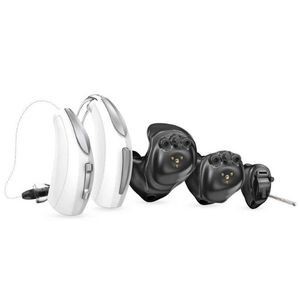
Starkey Hearing Aids UK
Starkey connectivity
Accessories and smartphone compatibility
Starkey has various hearing aid accessories available to improve your hearing and lifestyle, such as assisting in tricky hearing situations, watching TV, on the phone and much more. Find out more about which devices would work better for you by asking your audiologist.
The Thrive Hearing Control app runs on Android 7.0 and higher. The following phones have been tested and certified as compatible for streaming audio using a Starkey accessory.
Talk to your audiologist about which Android devices you can connect to. You should always check the compatibility with your audiologist in regards to iPhone connection, too. For example, Starkey's Thrive Hearing Control app runs on iOS 14 or 15.
Help, troubleshooting and support
All our audiologists will professionally advise you to help you choose the right Starkey hearing aid for you and your hearing loss, as well as give you the best aftercare and support going forward, including:
Starkey hearing aid adjustments, cleaning a Starkey hearing aid, Starkey hearing aid batteries, Starkey hearing aids have Bluetooth problems, like connectivity and pairing, the right Starkey hearing aid charger system for you and the different types of Starkey hearing aid domes.
Starkey battery life
How long do hearing aid batteries last from Starkey? On average, standard Starkey hearing aid batteries last 3 to 22 days, depending on your streaming usage, the type of hearing aid, the battery type, etc.
You don't have to worry about hearing aid battery life with the Lithium-ion rechargeable offerings, as they can give you a full day of use even when streaming from your phone and accessories after a full charge.
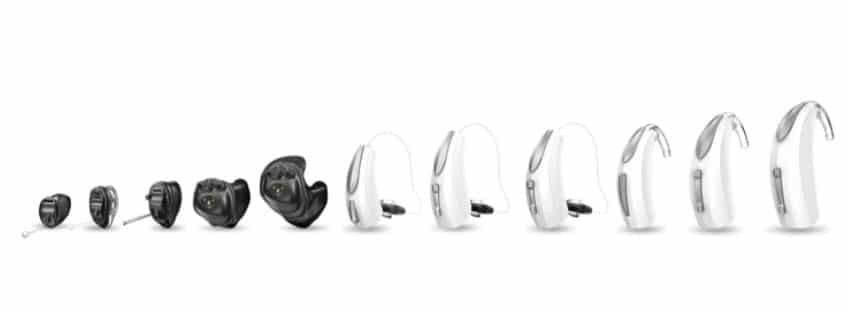
Starkey Hearing Aids UK
Notable Starkey hearing aid models
Starkey Omega AI hearing aids - Latest launch
The Starkey Omega AI range combines advanced intelligence with real-world practicality. Featuring DNN 360—the world’s first deep-neural-network directionality system—it analyses 80 million sound data points per hour to anticipate what you need to hear, not just react. Powered by the new G3 Neuro Processor, it delivers clearer, more natural speech and exceptional focus in noisy settings.
Available in RIC RT, mini RIC RT, ITC RT, and ITE RT styles, Omega AI offers up to 51 hours of battery life, full IP68 waterproofing, and advanced health tracking, including step-counting and fall detection. It’s built for active lifestyles—robust, connected, and designed to make hearing effortless wherever life takes you.
- Available in: 24, 20, 16 technology levels
- Key feature: Automatically adjusts to focus on speech
- Best for: Challenging hearing environments
- Starkey Omega AI 24 hearing aids
- Starkey Omega AI 20 hearing aids
- Starkey Omega AI 16 hearing aids
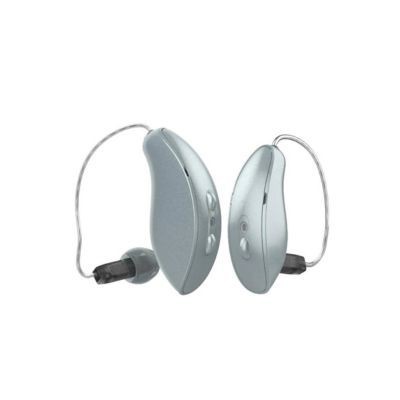
Starkey Edge AI hearing aids - Current
Starkey's Edge AI hearing aids harness advanced artificial intelligence to deliver clear sound, reduce listening fatigue, and improve speech understanding, even in challenging environments.
Featuring Bluetooth compatibility, long battery life, and a sleek, discreet design, these aids offer seamless streaming, fitness tracking, and fall detection.
With support for the LE Audio protocol and an app for easy control, they are equipped for modern connectivity and user convenience.
- Available in: 24, 20, 16 technology levels
- Key feature: Reduced listening fatigue
- Best for: Active users wanting health monitoring
- Starkey Edge AI 24 hearing aids
- Starkey Edge AI 20 hearing aids
- Starkey Edge AI 16 hearing aids
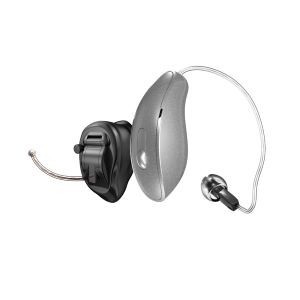
Starkey Signature Series hearing aids - Current
Launched in April 2024, the Signature Series hearing aids are the 2nd generation of Genesis AI, with the addition of motion-based optimisation and automated Edge Mode+; they are Starkey's smallest devices yet. This launch brought better Edge Mode+ and optimisation.
Once activated, using an optional push button, Edge Mode+ now operates automatically. It seamlessly transitions into a mode where it continuously scans, adapts, and optimises hearing based on changes in the surrounding listening environment.
- Available in: 24, 20, and 16 technology levels
- Key feature: Automatic environment adaptation
- Best for: Users wanting a discreet, automatic adjustment
- Starkey Signature Series 24 hearing aids
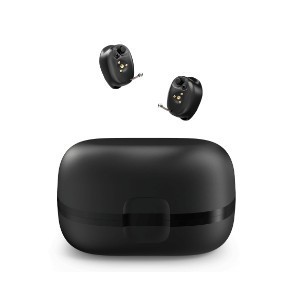
Starkey Genesis AI hearing aids - Current
Designed with a ground-breaking approach to hearing loss that goes beyond just amplification, these cutting-edge hearing aids are engineered to use their AI capabilities to redefine the way we process sound.
Released in October 2023, a year after the Starkey Evolv AI range, the new Genesis AI range is said to offer real breakthrough advances in what Starkey terms ‘Ear-Brain Technology’ - not just incremental improvements.
Compared to Starkey Evolv AI, Starkey Genesis AI is an entirely new platform, featuring a complete redesign, inside and out, including all-new hardware and an innovative chip known as the Starkey Neuro Processor.
- Available in: 24, 20, 16 technology levels
- Key feature: Revolutionary sound processing
- Best for: Users wanting advanced AI technology
- Starkey Genesis AI 24 hearing aids
- Starkey Genesis AI 20 hearing aids
- Starkey Genesis AI 16 hearing aids
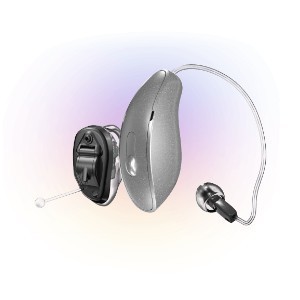
Starkey Evolv AI hearing aids - Superseded
Starkey's latest hearing aid technology, Evolv AI, a modern black hearing aid, was designed to give wearers a complete device range to suit everyone, whilst developing their healthable and holistic approach to hearing started back in 2018 with Livio. This range includes a wireless CIC-style hearing aid and four technology levels.
Along with advanced hearing technology, connectivity and adaptable personalisation, you can also benefit from advanced automation. Starkey Evolv AI hearing aids have the potential to enhance your hearing health and overall wellness.
Starkey's latest 'healthable' hearing aid launch, in 2020, was the Livio Edge AI - the world's first rechargeable custom hearing aid. Including Starkey's famous artificial intelligence technology and great sound experience.
- Available in: 2400, 2000, 1600, 1200, 1000 technology level
- Key feature: Holistic health monitoring
- Status: These have been replaced by newer models
- Starkey Evolv AI 2400 hearing aids
Starkey hearing aid summary
Starkey is the only American-owned hearing aid brand, renowned for innovation and philanthropy. Their range includes advanced AI-powered models like Genesis AI, Signature Series, and Edge AI, featuring Bluetooth, rechargeability, health monitoring, tinnitus support, and spatial awareness.
Starkey’s user-friendly apps and advanced technology deliver smart, discreet hearing solutions tailored to diverse lifestyles and budgets.
Discover Starkey Today
Experience better hearing with confidence. Starkey hearing aids combine advanced technology, discreet design, and health-focused innovation, all supported by expert audiologists who truly care.
We're proud to be rated “Excellent” by our customers on Reviews.io – a reflection of the personal service and life-changing results we aim to deliver every day.
Book your free consultation today and let us help you find the right hearing solution - no pressure, just honest, professional advice. Call us free on 0800 567 7621
Our specialist service includes:
Do not spend hundreds of pounds without getting a second opinion from us.
Please call us on 0800 567 7621
 Not only are the prices great, but the service is fantastic! Many thanks to your team.
Not only are the prices great, but the service is fantastic! Many thanks to your team.New Starkey Hearing Aids in the UK
Watch the Starkey Hearing Aid Video Below
What's included in our hearing aid prices?
Common FAQs about Starkey Hearing Aids in the UK
How long is the Starkey manufacturer's hearing aid warranty?
The Starkey manufacturer's hearing aid warranty is 5 years.
What mobile phones are compatible with Starkey hearing aids?
The latest Starkey hearing aids are Made for Any Phone hearing devices. This means that they are compatible with both iPhone and Android mobiles. However, there are compatibility requirements, so you must check with your audiologist to see if yours can be paired with your Starkey hearing aids.
What hearing aid Starkey accessories can I use with my Starkey hearing aids?
New Starkey hearing aids are wireless it means that they have Bluetooth and can be connected to Starkey accessories. However, like most pairings - there are compatibility requirements. Check with your audiologist to see which accessories can be connected to your Starkey hearing aids.
Other pages you might find useful
Ask the Experts
6 Morton Lane
Walkwood
Redditch
Worcestershire
B97 5QA
Latest Launch
When we refer to a product as 'Latest Launch', we mean it is the latest to be released on the market.
New
When we refer to a product as 'New', we mean that the product is the newest hearing aid model on the market.
When we refer to a product as 'Superseded', we mean that there is a newer range available which replaces and improves on this product.
Older Model
When we refer to a product as an 'Older Model', we mean that it is has been superseded by at least two more recent hearing aid ranges.


